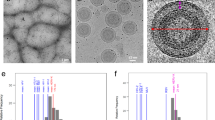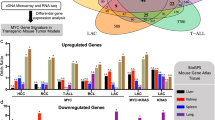Abstract
A specific protein of molecular weight (MW) ∼55,000 (55K) was found recently by immunoprecipitation in all SV40 virus-transformed mammalian cells1–8, in addition to the SV40 large T antigen (∼94K) and small t antigen (∼17K), which are the only proteins coded by the ‘early half’ of the SV40 genome. The 55K protein is encoded by cellular DNA; its peptide pattern is different from that of the SV40 antigens and it is species specific in mouse, rat, hamster, monkey and human SV40-transformed (or infected) cells6–9. A 55K protein with a similar peptide pattern was found in mouse embryonal carcinoma cells not exposed to SV404,5. Similar proteins were reported in mouse sarcomas and leukaemias induced by a great variety of aetiological agents and also in a spontaneously transformed mouse fibroblast cell line10, and it has been suggested that the protein may be a general correlate of cellular tumorigenicity11–13. We now report that the ∼55K protein is present in primary cell cultures from 12–14-day old mouse embryos, but not in 16-day old mouse embryos. The embryo protein has a peptide pattern virtually indistinguishable from that of the SV40-induced protein. We also show by comparing closely related cell families that spontaneously transformed highly tumorigenic mouse cells do not possess the 55K protein.
This is a preview of subscription content, access via your institution
Access options
Subscribe to this journal
Receive 51 print issues and online access
$199.00 per year
only $3.90 per issue
Buy this article
- Purchase on Springer Link
- Instant access to full article PDF
Prices may be subject to local taxes which are calculated during checkout
Similar content being viewed by others
References
Chang, C., Simmons, D. T., Martin, M. A. & Mora, P. T. J. Virol. 31, 463–471 (1979).
Kress, M., May, E., Cassingena, R. & May, P. J. Virol. 31, 472–483 (1979).
Melero, J. A., Stitt, D. T., Mangel, W. F. & Carroll, R. B. Virology 93, 466–480 (1979).
Linzer, D. I. H. & Levine, A. J. Cell 17, 43–52 (1979).
Linzer, D. I. H., Maltzman, W. & Levine, A. J. Virology 98, 308–318 (1979).
Smith, A. E., Smith, R. & Faucha, E. Cell 18, 335–346 (1979).
Melero, J. A., Tur, S. & Carroll, R. B. Proc. natn. Acad. Sci. U.S.A. 77, 97–101 (1980).
Simmons, D. T., Martin, M. A., Mora, P. T. & Chang, C. J. Virol. 44, 650–657 (1980).
Simmons, D. J. Virol. 36, 519–525 (1980).
DeLeo, A. J. et al. Proc. natn. Acad. Sci. U.S.A. 76, 2420–2424 (1979).
Jay, G. et al. Cold Spring Harb. Symp. quant. Biol. 44, 469–664 (1980).
Pollack, R. et al. Cold Spring Harb. Symp. quant. Biol. 44, 681–688 (1980).
Luka, J., Jörnvall, H. & Klein, G. J. Virol. 35, 592–602 (1980).
Segal, S., Levine, A. J. & Khoury, G. Nature 280, 335–338 (1979).
Cleveland, D. W., Fischer, S. G., Kirschner, M. W. & Laemmli, U. K. J. biol. Chem. 252, 1102–1106 (1977).
Küster, J. M., Mora, P. T., Brown, M. & Khoury, G. Proc. natn. Acad. Sci. U.S.A. 74, 4796–4800 (1977).
Lane, D. P. & Crawford, L. V. Nature 278, 261–263 (1979).
Weppner, W. A. & Coggin, J. H. Jr Cancer Res. 40, 1380–1387 (1980).
Mora, P. T., Chang, C., Couvillion, L., Küster, J. M. & McFarland, V. W. Nature 269, 36–40 (1977).
Winterbourne, D. J. & Mora, P. T. J. biol. Chem. 253, 5109–5120 (1978).
McFarland, V. W., Mora, P. T., Schultz, A. & Pancake, S. J. cell. Physiol. 95, 101–111 (1975).
Laemmli, U. K. Nature 227, 680–685 (1970).
Author information
Authors and Affiliations
Rights and permissions
About this article
Cite this article
Mora, P., Chandrasekaran, K. & McFarland, V. An embryo protein induced by SV40 virus transformation of mouse cells. Nature 288, 722–724 (1980). https://doi.org/10.1038/288722a0
Received:
Accepted:
Issue Date:
DOI: https://doi.org/10.1038/288722a0
This article is cited by
-
The onset of p53-dependent apoptosis plays a role in terminal differentiation of human normoblasts
Oncogene (2003)
-
Accentuated apoptosis in normally developing p53 knockout mouse embryos following genotoxic stress
Oncogene (1999)
-
Twenty years of p53 research: structural and functional aspects of the p53 protein
Oncogene (1999)
-
A functionally inactive p53 protein interatocarcinoma cells is activated by either DNA damage or cellular differentiation
Nature Medicine (1996)
-
Electrophoretic detection of protein p53 in human leukocytes
Bulletin of Experimental Biology and Medicine (1985)
Comments
By submitting a comment you agree to abide by our Terms and Community Guidelines. If you find something abusive or that does not comply with our terms or guidelines please flag it as inappropriate.



